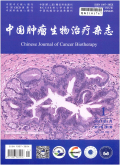中国肿瘤生物治疗杂志2024,Vol.31Issue(3):261-270,10.DOI:10.3872/j.issn.1007-385x.2024.03.008
基于GINS家族成员在胶质瘤组织中的表达水平对其进行分型及其临床意义
Classification of GINS family members based on their expression levels in glioma tissues and its clinical significance
摘要
Abstract
Objective:The classification of GINS family members based on their expression level in glioma tissue was explored to predict the prognosis of glioma patients,the efficacy of immunotherapy and the small molecules of traditional Chinese medicine.Methods:The database analyzed the relationship between GINS genomics,differentially expressed genes in glioma tissue and patient prognosis.Classification of gliomas based on gene expression of GINS family members and analysis of the prognosis of each subtype.Database data was analyzed for mutations,gene enrichment,tumor purity and immune cell infiltration scores for each subtype,as well as for Chinese traditional medicine small molecules that may interact with GINS2.Finally,the expression levels of GINS1~4 mRNA in Chinese human glioma tissues were detected by qPCR to verify their consistency with the database data.Results:GINS family members share similarities in gene,protein structure and function.Furthermore,they are highly expressed in glioma tissues and are strongly associated with poor patient prognosis(P<0.05).The classification of S1 and S2 subtypes based on the expression level of GINS family members in glioma tissue can better predict the prognosis of glioma patients.The main mutant genes of the S1 subtype are CDKN2A/B,EGFR and PTEN,while the mutant genes of the S2 subtype are IDH1,TP53 and ATRX.In addition,GINS family may affect the prognosis of glioma patients by regulating the immune microenvironment.CD276,and CX3CL1 may be potential targets for immunotherapy in patients with S1 subtype glioma.CHEMBL66033,266935,293914,436859 and 1594881 May be the potential Chinese medicine small molecules targeting GINS2.Conclusion:The molecular typing of glioma constructed based on GINS family helps identify high-risk patients more suitable for immunotherapy,and the selected traditional Chinese medicine small molecules can provide a reference for molecular targeted therapy and immunotherapy for glioma patients.关键词
胶质瘤/GINS家族/分子分型/预后/分子对接/中药Key words
glioma/GINS family/molecular typing/prognosis/molecular docking/traditional chinese medicine分类
临床医学引用本文复制引用
廖永珍,梁禄,李意,丛丽..基于GINS家族成员在胶质瘤组织中的表达水平对其进行分型及其临床意义[J].中国肿瘤生物治疗杂志,2024,31(3):261-270,10.基金项目
湖南省自然科学基金(No.2023JJ30425) (No.2023JJ30425)
湖南省卫生健康委科研课题(No.202103011683) (No.202103011683)

